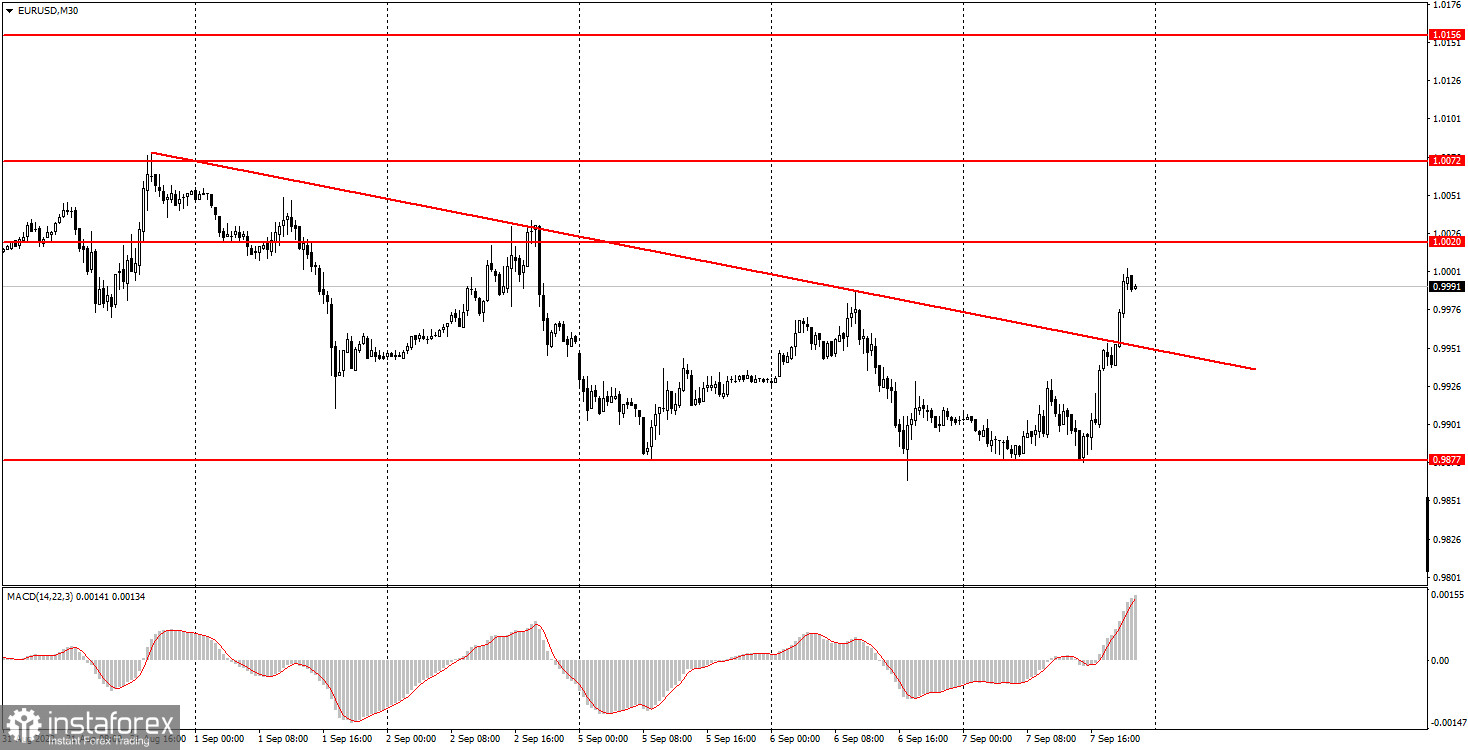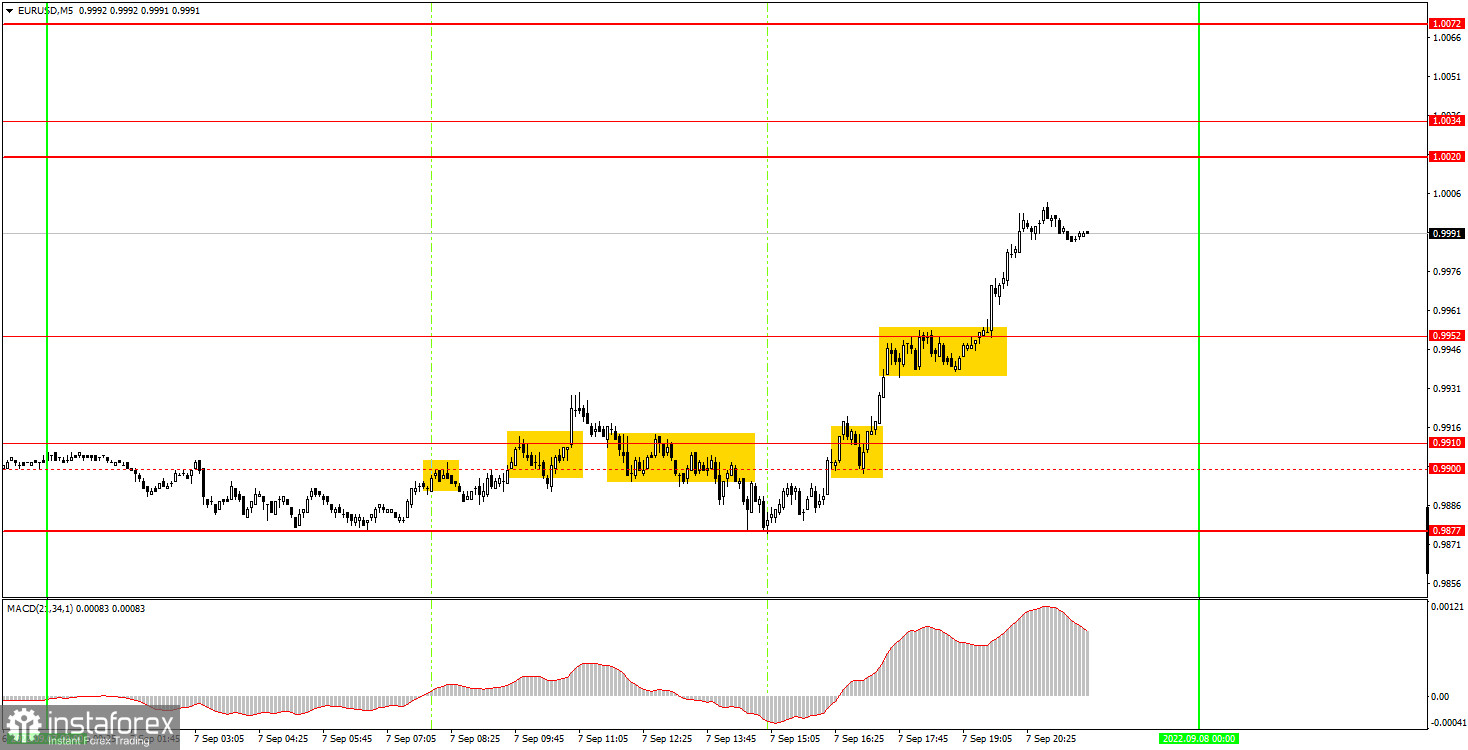Analysis of Wednesday's deals:
30M chart of the EUR/USD pair

The EUR/USD currency pair traded very weakly on Wednesday. There were no important reports and events during the day. At least that's what the market thought. In fact, at least the report on EU GDP for the second quarter was published. And although it was the third assessment, that is, traders were already mentally prepared to see a certain increase in the economy, the report still cannot be considered insignificant. Moreover, its value has grown to 0.8% compared to 0.6% in previous estimates. The euro eventually showed growth, but did so only in the US trading session, failing to overcome the level of 0.9877 for the second time. The descending trendline is no longer relevant as the price has consolidated above it. Thus, formally long positions can now be considered, but how long the growth will continue is an open question. Remember that the price currently remains near its 20-year lows and is located in close proximity to them. There was no strong upward correction, so we are counting on the resumption of the downward movement. The level of 0.9900 was corrected to the value of 0.9877, which the price hit three times this week.
5M chart of the EUR/USD pair

It is clearly seen on the 5-minute timeframe that the pair was in an intraday flat. Consequently, trading was very difficult and unprofitable. Several trading signals were formed on Wednesday, but for obvious reasons, they all turned out to be false. Unfortunately, it is impossible to predict in advance when the flat will begin. Therefore, novice players were forced to work out the signals that were at their disposal. First, the price rebounded from the level of 0.9900, then overcame the level of 0.9910, then again settled below the level of 0.9900. In none of the three cases could the pair pass even 15 points in the right direction. Beginners could work out only the first two signals. Since they turned out to be false, all subsequent signals near the 0.9900-0.9910 area should not have been worked out. Unfortunately, the profit made the day before was eaten up on Wednesday. The fourth and fifth signals should not have been worked out either, since the fourth one was formed in the same area of 0.9900-0.9910, and the fifth one was too late in time. Therefore, even a good upward movement in the second half of the day failed to work out.
How to trade on Thursday:
The pair continues to gravitate toward a downward movement on the 30-minute timeframe. Despite the fact that the euro has been falling for a very long time and strongly and, undoubtedly, is very oversold, the geopolitical and fundamental backgrounds do not give traders grounds for strong longs. The correction for the pair has begun, but so far it is very difficult to say what caused the euro to grow and how long this movement will continue. 20-year lows should be traded with caution anyway. On the 5-minute time frame on Thursday it is recommended to trade at the levels (Wednesday's low), 0.9877, 0.9910, 0.9952, 1.0020-1.0034, 1.0072, 1.0123. When passing 15 points in the right direction, you should set Stop Loss to breakeven. The "event of the week" will take place in the European Union. The results of the European Central Bank meeting will be announced and the rate will almost certainly be increased by 0.5-0.75%. Theoretically, the euro can respond with growth, but in practice, the market reaction can be absolutely anything.
Basic rules of the trading system:
1) The signal strength is calculated by the time it took to form the signal (bounce or overcome the level). The less time it took, the stronger the signal.
2) If two or more deals were opened near a certain level based on false signals (which did not trigger Take Profit or the nearest target level), then all subsequent signals from this level should be ignored.
3) In a flat, any pair can form a lot of false signals or not form them at all. But in any case, at the first signs of a flat, it is better to stop trading.
4) Trade deals are opened in the time period between the beginning of the European session and until the middle of the US one, when all deals must be closed manually.
5) On the 30-minute TF, using signals from the MACD indicator, you can trade only if there is good volatility and a trend, which is confirmed by a trend line or a trend channel.
6) If two levels are located too close to each other (from 5 to 15 points), then they should be considered as an area of support or resistance.
On the chart:
Support and Resistance Levels are the Levels that serve as targets when buying or selling the pair. You can place Take Profit near these levels.
Red lines are the channels or trend lines that display the current trend and show in which direction it is better to trade now.
The MACD indicator (14,22,3) consists of a histogram and a signal line. When they cross, this is a signal to enter the market. It is recommended to use this indicator in combination with trend lines (channels and trend lines).
Important speeches and reports (always contained in the news calendar) can greatly influence the movement of a currency pair. Therefore, during their exit, it is recommended to trade as carefully as possible or exit the market in order to avoid a sharp price reversal against the previous movement.
Beginners on Forex should remember that not every single trade has to be profitable. The development of a clear strategy and money management are the key to success in trading over a long period of time.
 English
English 
 Русский
Русский Bahasa Indonesia
Bahasa Indonesia Bahasa Malay
Bahasa Malay ไทย
ไทย Español
Español Deutsch
Deutsch Български
Български Français
Français Tiếng Việt
Tiếng Việt 中文
中文 বাংলা
বাংলা हिन्दी
हिन्दी Čeština
Čeština Українська
Українська Română
Română

